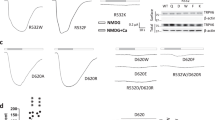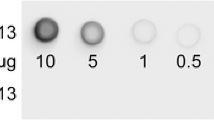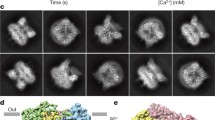Abstract
The serum- and glucocorticoid-inducible kinase SGK1 and the protein kinase PKB/Akt presumably phosphorylate and, by this means, activate the mammalian phosphatidylinositol-3-phosphate-5-kinase PIKfyve (PIP5K3), which has in turn been shown to regulate transporters and channels. SGK1-regulated channels include the Ca2+ channel TRPV6, which is expressed in a variety of epithelial and nonepithelial cells including tumor cells. SGK1 and protein kinase B PKB/Akt foster tumor growth. The present study thus explored whether TRPV6 is regulated by PIKfyve. TRPV6 was expressed in Xenopus laevis oocytes with or without additional coexpression of constitutively active S422DSGK1, constitutively active T308D,S473DPKB, wild-type PIKfyve, and S318APIKfyve lacking the SGK1 phosphorylation site. TRPV6 activity was determined from the current (ICa) resulting from TRPV6-induced Ca2+ entry and subsequent activation of Ca2+-sensitive endogenous Cl− channels. TRPV6 protein abundance in the cell membrane was determined utilizing immunohistochemistry and Western blotting. In TRPV6-expressing oocytes IH was increased by coexpression of S422DSGK1 and by T308D,S473DPKB. Coexpression of wild-type PIKfyve further increased IH in TRPV6 + S422DSGK1-expressing oocytes but did not significantly modify ICa in oocytes expressing TRPV6 alone. S318APIKfyve failed to significantly modify ICa in the presence and absence of S422DSGK1. S422DSGK1 increased the TRPV6 protein abundance in the cell membrane, an effect augmented by additional expression of wild-type PIKfyve. We conclude that PIKfyve participates in the regulation of TRPV6.





Similar content being viewed by others
References
Berwick DC, Dell GC, Welsh GI et al (2004) Protein kinase B phosphorylation of PIKfyve regulates the trafficking of GLUT4 vesicles. J Cell Sci 117:5985–5993
Boehmer C, Laufer J, Jeyaraj S et al (2008a) Modulation of the voltage-gated potassium channel Kv1.5 by the SGK1 protein kinase involves inhibition of channel ubiquitination. Cell Physiol Biochem 22:591–600
Boehmer C, Palmada M, Klaus F et al (2008b) The peptide transporter PEPT2 is targeted by the protein kinase SGK1 and the scaffold protein NHERF2. Cell Physiol Biochem 22:705–714
Bohmer C, Palmada M, Kenngott C et al (2007) Regulation of the epithelial calcium channel TRPV6 by the serum and glucocorticoid-inducible kinase isoforms SGK1 and SGK3. FEBS Lett 581:5586–5590
Bolanz KA, Hediger MA, Landowski CP (2008) The role of TRPV6 in breast carcinogenesis. Mol Cancer Ther 7:271–279
Embark HM, Bohmer C, Palmada M et al (2004) Regulation of CLC-Ka/barttin by the ubiquitin ligase Nedd4-2 and the serum- and glucocorticoid-dependent kinases. Kidney Int 66:1918–1925
Fukushima A, Aizaki Y, Sakuma K (2009) Short-chain fatty acids induce intestinal transient receptor potential vanilloid type 6 expression in rats and Caco-2 cells. J Nutr 139:20–25
Grahammer F, Henke G, Sandu C et al (2006) Intestinal function of gene-targeted mice lacking serum- and glucocorticoid-inducible kinase 1. Am J Physiol Gastrointest Liver Physiol 290:G1114–G1123
Heine G, Niesner U, Chang HD et al (2008) 1,25-dihydroxyvitamin D(3) promotes IL-10 production in human B cells. Eur J Immunol 38:2210–2218
Ikonomov OC, Sbrissa D, Shisheva A (2001) Mammalian cell morphology and endocytic membrane homeostasis require enzymatically active phosphoinositide 5-kinase PIKfyve. J Biol Chem 276:26141–26147
Ikonomov OC, Sbrissa D, Mlak K et al (2002) Functional dissection of lipid and protein kinase signals of PIKfyve reveals the role of PtdIns 3, 5-P2 production for endomembrane integrity. J Biol Chem 277:9206–9211
Ikonomov OC, Sbrissa D, Foti M et al (2003) PIKfyve controls fluid phase endocytosis but not recycling/degradation of endocytosed receptors or sorting of procathepsin D by regulating multivesicular body morphogenesis. Mol Biol Cell 14:4581–4591
Ikonomov OC, Sbrissa D, Shisheva A (2006) Localized PtdIns 3, 5-P2 synthesis to regulate early endosome dynamics and fusion. Am J Physiol Cell Physiol 291:C393–C404
Klaus F, Palmada M, Lindner R et al (2008) Up-regulation of hypertonicity-activated myo-inositol transporter SMIT1 by the cell volume-sensitive protein kinase SGK1. J Physiol 586:1539–1547
Klaus F, Laufer J, Czarkowski K et al (2009) PIKfyve-dependent regulation of the Cl− channel ClC-2. Biochem Biophys Res Commun 381:407–411
Lallet-Daher H, Roudbaraki M, Bavencoffe A, et al (2009) Intermediate-conductance Ca(2+)-activated K(+) channels (IK(Ca1)) regulate human prostate cancer cell proliferation through a close control of calcium entry. Oncogene 28:1792–1806
Lang F, Bohmer C, Palmada M et al (2006) (Patho)physiological significance of the serum- and glucocorticoid-inducible kinase isoforms. Physiol Rev 86:1151–1178
Lehen’kyi V, Flourakis M, Skryma R et al (2007) TRPV6 channel controls prostate cancer cell proliferation via Ca(2+)/NFAT-dependent pathways. Oncogene 26:7380–7385
Prevarskaya N, Zhang L, Barritt G (2007) TRP channels in cancer. Biochim Biophys Acta 1772:937–946
Rexhepaj R, Rotte A, Kempe DS et al (2009) Stimulation of electrogenic intestinal dipeptide transport by the glucocorticoid dexamethasone. Pflugers Arch 459:191–202
Rotte A, Bhandaru M, Foller M et al (2009a) APC sensitive gastric acid secretion. Cell Physiol Biochem 23:133–142
Rotte A, Mack AF, Bhandaru M et al (2009b) Pioglitazone induced gastric acid secretion. Cell Physiol Biochem 24:193–200
Rusten TE, Rodahl LM, Pattni K et al (2006) Fab1 phosphatidylinositol 3-phosphate 5-kinase controls trafficking but not silencing of endocytosed receptors. Mol Biol Cell 17:3989–4001
Rutherford AC, Traer C, Wassmer T et al (2006) The mammalian phosphatidylinositol 3-phosphate 5-kinase (PIKfyve) regulates endosome-to-TGN retrograde transport. J Cell Sci 119:3944–3957
Sandu C, Artunc F, Grahammer F et al (2007) Role of the serum and glucocorticoid inducible kinase SGK1 in glucocorticoid stimulation of gastric acid secretion. Pflugers Arch 455:493–503
Sato JD, Chapline MC, Thibodeau R et al (2007) Regulation of human cystic fibrosis transmembrane conductance regulator (CFTR) by serum- and glucocorticoid-inducible kinase (SGK1). Cell Physiol Biochem 20:91–98
Sbrissa D, Ikonomov OC, Shisheva A (1999) PIKfyve, a mammalian ortholog of yeast Fab1p lipid kinase, synthesizes 5-phosphoinositides. Effect of insulin. J Biol Chem 274:21589–21597
Sbrissa D, Ikonomov OC, Deeb R et al (2002) Phosphatidylinositol 5-phosphate biosynthesis is linked to PIKfyve and is involved in osmotic response pathway in mammalian cells. J Biol Chem 277:47276–47284
Sbrissa D, Ikonomov OC, Strakova J et al (2004) Role for a novel signaling intermediate, phosphatidylinositol 5-phosphate, in insulin-regulated F-actin stress fiber breakdown and GLUT4 translocation. Endocrinology 145:4853–4865
Seebohm G, Strutz-Seebohm N, Birkin R et al (2007) Regulation of endocytic recycling of KCNQ1/KCNE1 potassium channels. Circ Res 100:686–692
Semenova SB, Vassilieva IO, Fomina AF, et al (2009) Endogenous expression of TRPV5 and TRPV6 calcium channels in human leukemia K562 cells. Am J Physiol Cell Physiol 296:C1098–C1104
Shaw JR, Sato JD, Vander Heide J et al (2008) The role of SGK and CFTR in acute adaptation to seawater in Fundulus heteroclitus. Cell Physiol Biochem 22:69–78
Shojaiefard M, Strutz-Seebohm N, Tavare JM et al (2007) Regulation of the Na(+), glucose cotransporter by PIKfyve and the serum and glucocorticoid inducible kinase SGK1. Biochem Biophys Res Commun 359:843–847
Strutz-Seebohm N, Seebohm G, Mack AF et al (2005) Regulation of GluR1 abundance in murine hippocampal neurones by serum- and glucocorticoid-inducible kinase 3. J Physiol 565:381–390
Strutz-Seebohm N, Gutcher I, Decher N et al (2007a) Comparison of potent Kv1.5 potassium channel inhibitors reveals the molecular basis for blocking kinetics and binding mode. Cell Physiol Biochem 20:791–800
Strutz-Seebohm N, Shojaiefard M, Christie D et al (2007b) PIKfyve in the SGK1 mediated regulation of the creatine transporter SLC6A8. Cell Physiol Biochem 20:729–734
Stumpf T, Zhang Q, Hirnet D et al (2008) The human TRPV6 channel protein is associated with cyclophilin B in human placenta. J Biol Chem 283:18086–18098
Takumida M, Ishibashi T, Hamamoto T et al (2009) Age-dependent changes in the expression of klotho protein, TRPV5 and TRPV6 in mouse inner ear. Acta Otolaryngol 25:1–11
Thyagarajan B, Lukacs V, Rohacs T (2008) Hydrolysis of phosphatidylinositol 4,5-bisphosphate mediates calcium-induced inactivation of TRPV6 channels. J Biol Chem 283:14980–14987
Thyagarajan B, Benn BS, Christakos S et al (2009) Phospholipase C-mediated regulation of transient receptor potential vanilloid 6 channels: implications in active intestinal Ca2+ transport. Mol Pharmacol 75:608–616
van de Graaf SF, Hoenderop JG, Bindels RJ (2006) Regulation of TRPV5 and TRPV6 by associated proteins. Am J Physiol Renal Physiol 290:F1295–F1302
Watson RT, Pessin JE (2006) Bridging the GAP between insulin signaling and GLUT4 translocation. Trends Biochem Sci 31:215–222
Welsh GI, Hers I, Berwick DC et al (2005) Role of protein kinase B in insulin-regulated glucose uptake. Biochem Soc Trans 33:346–349
Wulff P, Vallon V, Huang DY et al (2002) Impaired renal Na(+) retention in the sgk1-knockout mouse. J Clin Invest 110:1263–1268
Acknowledgments
The authors acknowledge the technical assistance of E. Faber and the meticulous preparation of the manuscript by T. Loch and L. Subasic. This study was supported by the Deutsche Forschungsgemeinschaft (GK 1302, SFB 773). S422DSGK1 and PKB cDNA were kindly provided by Sir Philip Cohen, College of Life Sciences, and Sir James Black Centre, University of Dundee; PIKfyve cDNA, by Jeremy M. Tavaré, University of Bristol.
Author information
Authors and Affiliations
Corresponding author
Rights and permissions
About this article
Cite this article
Sopjani, M., Kunert, A., Czarkowski, K. et al. Regulation of the Ca2+ Channel TRPV6 by the Kinases SGK1, PKB/Akt, and PIKfyve. J Membrane Biol 233, 35–41 (2010). https://doi.org/10.1007/s00232-009-9222-0
Received:
Accepted:
Published:
Issue Date:
DOI: https://doi.org/10.1007/s00232-009-9222-0




